PBSCV1599

Gen. James Patton Anderson Camp 1599
Celebrating 34 Years 1992 - 2026
Captain Andrew James Lewis



Andrew James Lewis, 1817-1911 Became first Sr. Warden at 91
Capt. Andrew James Lewis
Andrew enlisted in Confederate states Army on may 10 1861 at Corinth, Mississippi. He was mustered as a first Lieut. in Company K, 12th Mississippi Infantry. He resigned from Regiment the on September 2, 1861 due to sickness. He later enlisted as captain of Company B, 24th Battalion Mississippi Cavalry. Date of enlistment are unknown but he was paroled on May 12, 1865 at Gainesville, Alabama
Judge Andrew James Lewis was a native of Charleston, South Carolina and was born on May 15, 1818. In 1838 he removed to Massachusetts and in 1857 he went to Port Gibson, Mississippi where he practiced his chosen profession as a lawyer. During the Civil War he served in the Mississippi Cavalry and towards the close of the war was made a Lieut. Col. commanding the 24th Batta-lion. His command numbered only thirty-eight men and was not attached to any regiment. After the battle, Lewis fell back to Port Hudson with the defeated Confederates.. In 1886 he came to Florida and settled on the Indian River at Fort Pierce and in 1899 he went to West Palm Beach where he built up a lucrative practice. Judge Lewis was much in the public life having been elected to the legislature of Massachusetts for two terms. He was the first Democrat elected from his town on party lines. He also served in the Mississippi legislature during the years of 1869 in 1880. He was deeply interested in church work having been a member of the Holy Trinity Episcopal Church of West Palm Beach since its beginning and was it senior warden. He was also be organizer of holy Trinity Sunday school where he was superintendent. During many years it has been the custom of the pupils of the school each year at his birthday on May 15, to gather at his home where he was presented with many tokens of remembrance.
He was a loyal Mason for a period of 66 years. He was one of the oldest Democrats, and an enterprising and capable lawyer, a genial and progressive citizen. Judge Lewis died at the home of his daughter, Mrs. Rosa Everett. A host of friends in the counties of Palm Beach, St. Lucie, Brevard and Dade who mourn his death and who extend his daughter their sincerest sympathy in her bereavement.
He was married to Mary Hutchinson Spindle, the daughter of Thomas Goulder Spindle and Mary Hutchinson. Mary was born about 1835 in Mississippi. Andrew and Mary had at least one daughter Mary Rosa Hutchinson Lewis who was born on March 18, 1874, in Port Gibson, Mississippi. Rosa was married the first time to Frank Barrows Everette who was born in 1869 in Connecticut and died in 1901 in Lake Worth, Palm Beach County (Then Dade) and is buried at Woodlawn Cemetery, West Palm Beach. After the death of her father, Rosa married for the second time to Mr. John H. Williams who was born in Arkansas.
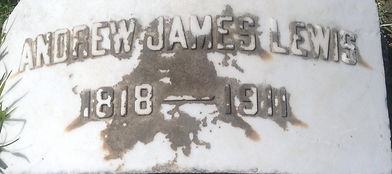
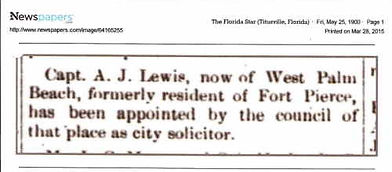
HOLY TRINITY EPISCOPAL CHURCH | WEST PALM BEACH FLORIDA
Rev. Henry served as Holy Trinity's first Rector, and Andrew J. Lewis as the first Senior Warden. Under their leadership the rectory was enlarged and improved, and in 1910 a building fund was inaugurated. During all these years, whenever the church at intervals lacked a priest, services were held through the devotion of Col. R. Over-end Davies as Lay Reader
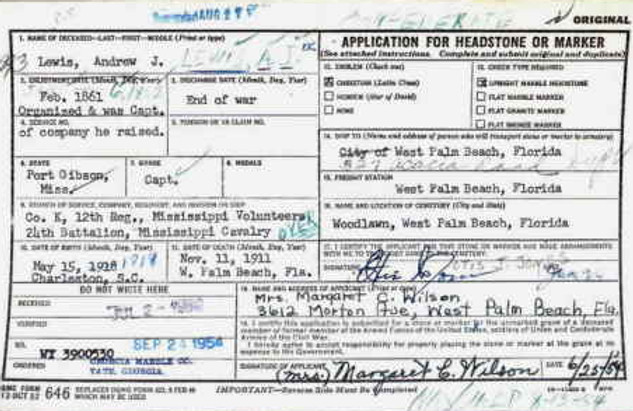
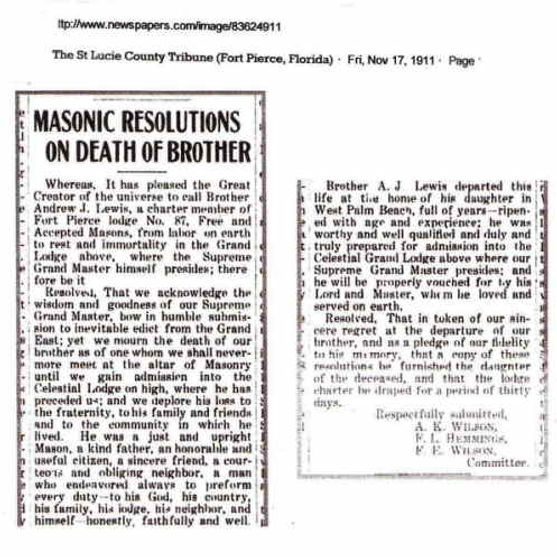
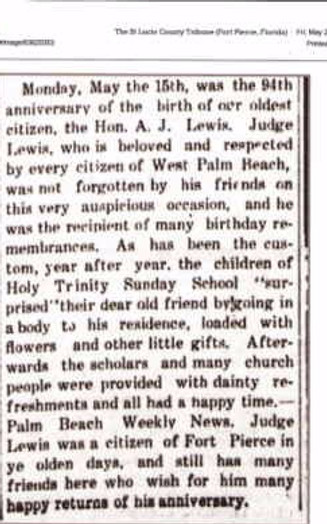

The St. Lucie County Tribune, Friday, September 15, 1911
JUDGE A.J. LEWIS ANSWERS SUMMONS
Judge A. J. Lewis, the first follower of Blackstone to hang his shingle in Fort Pierce, passed away at his home in West Palm Beach last Wednesday afternoon.
Although feeble foe several weeks past, his death was not entirely unexpected, yet the announcement came as a shock to the many friends who honored and loved him.. While having no ailments whatever, Judge Lewis, who was in his 94th year, gradually became more feeble and week and sank into a peaceful end. The only near relative surviving him is his daughter, Mrs. Rosa Everette.
The funeral was held Thursday afternoon from the late residence and was largely attended, the beautiful service of the Episcopal church being held by the Rev. Dr. Moore. A wreath of flowers covered the casket and many other beautiful emblems were placed on the grave at Woodlawn cemetery.
Judge Andrew James Lewis was a native of Charleston, S. C. where he was born May 15, 1818. In 1857 he removed to Massachusetts and in 1857 he went to Port Gibson, Miss. where he practiced his chosen profession as a lawyer. During the Civil War he served in the Mississippi cavalry and towards the close was made a Lieutenant Colonel commanding the Twenty-fourth battallian. In 1886 he came to Florida and settled on the Indian River at Fort Pierce and in 1890 he went to West Palm Beach where he built up a lucrative practice.
Judge Lewios was much in the public life having been elected to the legislature in Massachusetts for two terms. He was the 1st Democrat elected from his town on party lines. He also served in the Mississippi legislature during the years of 1869 and 1880.
He was deeply interested in church work , having been a member of Holy Trinity Episcopal church of that city since its beginning and was its senior warden. He was also the organizer of Holy Trinity Sunday school where he was superintendent to four years ago. During many years it has been the custom of the pupils at the school each year on his birthday, May 15, to gather at his home where he was presented with many tokens of remembrance. He was a loyal Mason for a period of sixty-six years. He was one of our oldest Democrats , an enterprising and capable lawyer, and a genial and progressive citizen.
Judge Lewis leaves a daughter, Mrs. Rosa Everette, and a host of friends in the counties of Palm Beach, St. Lucie, Brevard and Dade who mourn his death and who extend his daughter their sincrest sympathy in her bereavement.

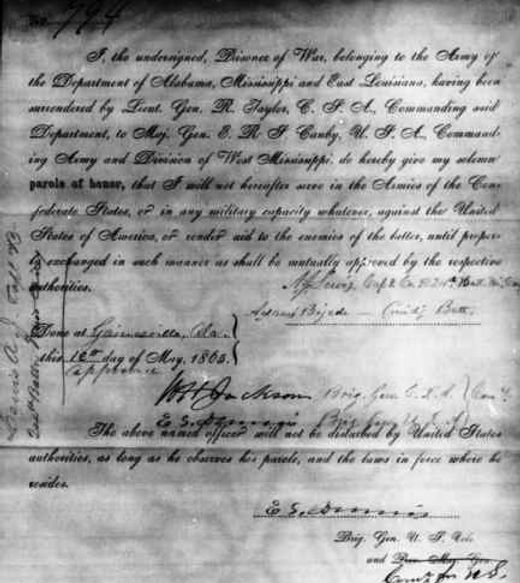

Frederick Y. Dabney (Seated Right)
James P. Parker (Seated Center)
Unknown (Seated Left)
W. B. Seawell (Standing Right)
A. J. Lewis (Standing Left)
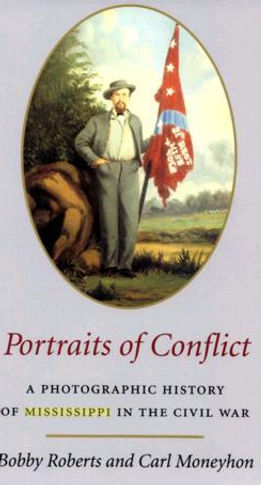
BIO. and Photo from Page 106
Capt. A. J. Lewis enlisted in the army at Port Gibson, Mississippi on June 6, 1862, and he led the Claiborne Light Infantry in the unsuccessful attack at Baton Rouge. His command numbered only thirty-eight men and was not attached to any regiment. After the battle, Lewis fell back to Port Hudson with the defeated Confederates.
THE LIBERTY MONUMENT
Perhaps the South's First Confederate Monument
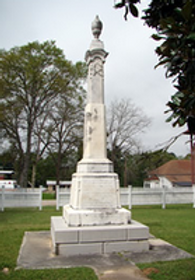
Confederate monuments are fairly commonplace in Mississippi and throughout the South, with many monuments erected on courthouse squares. The majority were erected in the late 19th century and were placed there by Confederate veterans themselves and their supporting organizations, chiefly the United Daughters of the Confederacy. Dedication ceremonies were big events, attracting thousands of veterans and curious onlookers, and usually involved a lot of longwinded speeches by politicians. The monuments have since become part of the Southern landscape. Among the earliest memorials to the “Lost Cause" is the Confederate monument in Liberty.
The move to erect a Confederate monument in Liberty began in 1866 with the laying of a cornerstone on property donated by the local Masonic Lodge, and the fundraising effort was undertaken by a local historical association organized the same year, and possibly among the first such groups in the South. Of course, the Civil War had barely ended in 1866 and the state was in the midst of Reconstruction. Needless to say, money was scarce. Over the next five years, however, the association managed to raise $3,332 for the monument.


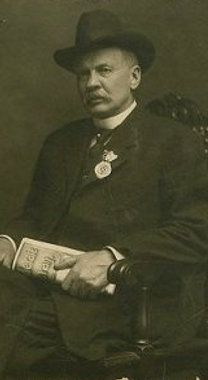
Designed and built by Captain A.J. Lewis of Port Gibson, who was himself a Confederate veteran, the result (above) was an Italian marble shaft more than twenty feet tall, along which are inscribed the names of the 279 Amite County Confederate dead. The monument includes the following dedication: "Sacred to the Memory of the Soldiers from Amite County Who Lost Their Lives in the Confederate Army." In the years to come, the monument was the scene of frequent reunions and ceremonies, as seen above, from around the turn of the century.
The monument was dedicated on April 26, 1871. Receiving the monument on behalf of the veterans was Lt. Col. Charles P. Neilson, a resident of Liberty and a veteran of the 22nd Mississippi Infantry. The monument at Liberty was the first of many such monuments in Mississippi, and is one of the earliest in the United States. Whether it is the very first Confederate monument, however, as some have claimed, is the subject of a century-old debate. In 1911, the Confederate Veteran magazine published an article about the Liberty monument based on information submitted by Liberty resident E.A. Causey. After waxing eloquently about the monument and stating that the sculpture"was certainly a fine credit to its people," the magazine's editor, S.A. Cunningham of Tennessee, stated that "To say that this was the first Confederate monument erected may be misleading. Without referring to dates, the impression prevails that the Bolivar [Tennessee] monument (above right) was erected several years before this one at Liberty."
In fact, the Bolivar, Tennessee, monument was erected in 1869, two years before the Liberty monument. In a subsequent issue of the magazine, however, David C. Bramlette, Jr. of Woodville wrote Cunningham (left) that "as early as November 18, 1866, my mother, Miss Olivia J. Ratcliffe, then a girl eighteen years old, presented to the Amite County Historical and Monumental Association a stone to be used for the corner stone in the monument.Col. Richard Stewart gave the stone to the association, and on the occasion of its presentation my mother made a stirring address, the original copy of which I still have in my possession."
In fact, the Bolivar, Tennessee, monument was erected in 1869, two years before the Liberty monument. In a subsequent issue of the magazine, however, David C. Bramlette, Jr. of Woodville wrote Cunningham (left) that "as early as November 18, 1866, my mother, Miss Olivia J. Ratcliffe, then a girl eighteen years old, presented to the Amite County Historical and Monumental Association a stone to be used for the corner stone in the monument.Col. Richard Stewart gave the stone to the association, and on the occasion of its presentation my mother made a stirring address, the original copy of which I still have in my possession."
Apparently, S.A. Cunnngham, editor of the Confederate Veteran, thought it best to let bygones be bygones, as he wisely chose not to engage further in the debate, leaving the question about which was actually the "first" monument for future generations to decide. Regardless, the Liberty Monument is definitely the first in Mississippi and is indeed "a fine credit to its people."

